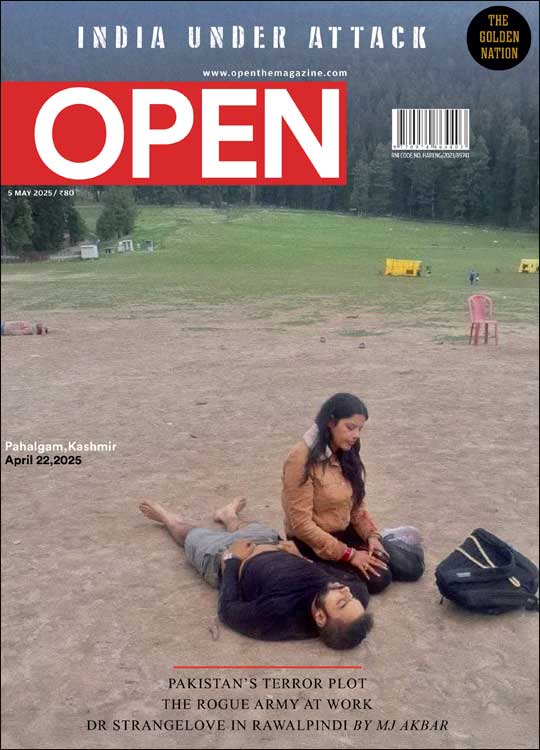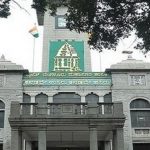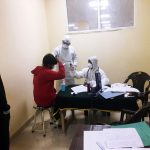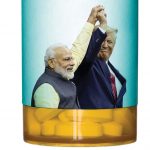Whose Herb Is It Anyway?
As India and China fight for ownership of the ancient practice of Sowa Rigpa, there is just one inconvenient fact. It belongs to Tibetans
 Lhendup G Bhutia
Lhendup G Bhutia
 Lhendup G Bhutia
Lhendup G Bhutia
 |
23 Aug, 2017
|
23 Aug, 2017
/wp-content/uploads/2017/08/Herb1.jpg)
“ARE YOU EATING well?” asks Kelsang Dolma, her three middle fingers arrayed over her patient’s forearm as though she were marking her position on a guitar’s fingerboard. “Are you well-rested?”
Dolma’s forehead and lips are scrunched in concentration, as she appears to listen to her patient’s pulse. And every few minutes, she asks another question, as though the pulse were conveying a new message.
Dolma is not your regular doctor. She doesn’t wear a white coat, or carry any instruments. On one wall in her office is a large framed photograph of the Dalai Lama and two thangkas.
Dressed in a Tibetan chuba, she is not just analysing pulses to measure the heartbeat, it turns out. To her it is an important diagnostic tool. In the branch of medicine that she practises, the inner and outer halves of the tips of the three middle fingers on both hands convey the health of every organ. The outside of the right middle finger, for instance, records the spleen. While the inside records the stomach.There are other unique methods of diagnosis, for instance a detailed analysis of urine, its odour, colour and other characteristics. The pulse too is an important indicator. “It is all in our fingertips,” Kelsang says jokingly.
We are at Koperkhairane, a rapidly growing intercity that connects two of Mumbai’s satellite towns, Thane and Navi Mumbai. Today, Dolma will see a number of patients, around 80. They suffer from serious ailments like liver cancer, failing kidneys and dengue. There is also a young woman with migraines who nudges her husband to ask—too embarrassed to do so herself—if there is a cure for the dark circles around her eyes.
Kelsang Dolma is a practitioner of Tibetan medicine or Sowa Rigpa (Tibetan for ‘science of learning’). Philosophically, the system is rooted in the Buddhist idea that all illnesses are ultimately the result of ‘ignorance’—the cause of all suffering, which generates the poisons of attachment, aversion and delusion, to put it simply. Treatments can range from medicines composed of natural materials to physical therapies like Tibetan acupuncture.
The survival of Tibetan medicine in India, and now outside, is a remarkable story of how an ancient practice was re-established in another country and has now gradually begun to flourish. There are Tibetan physicians setting up successful practices around the world. In India, Men-Tsee-Khang, an institution set up in Dharamshala to practice Tibetan medicine, has 51 clinics located across the country. It also runs health camps in various places.
But now, as Indian and Chinese troops face each other in a protracted impasse in the Himalayan region of Doklam, the governments of the two countries are also squaring off against each other in the chambers of the United Nations Educational, Scientific and Cultural Organisation (Unesco). Both countries claim that Tibetan medicine belongs to them. China wants Unesco to recognise a Tibetan medicinal bathing therapy known as ‘Lum’, a practice within Sowa Rigpa, as part of its ‘intangible cultural heritage.’ While India, in its own bid, has asked for all of Sowa Rigpa to be recognised as its own.
There is just one inconvenient fact: it belongs to Tibetans.
THE KEY TEXT of Tibetan medicine is the Four Tantras, a work said to have been authored by a physician, Yuthog Yontan Gonpo, in the 8th century CE. According to Tashi Tsering Phuri, director of Men-Tse-Khang, Gonpo is believed to have composed the text during a conference on medicine in Tibet’s Samye monastery which was attended by physicians from several countries, including Tibet, India, China, Nepal, Persia and Mongolia, by synthesising the best of the knowledge of all the systems of medicine practiced in these regions.
“Tibetan medicine has a history that is thousands of years old and in large part its origins stretch back before the written record and long before the current political borders were drawn,” says Lilly Atlihan, a Tibetan medicine practitioner, who along with her Tibetan physician husband, Palnam Jinpa, runs a practice in New York. “China and India have two of the oldest cultures in the world. Tibetan culture has a similarly deep history and it goes without saying that Tibetan medicine has been in conversation with its neighbouring cultures throughout its development.”
After the escape of several Tibetans to India following the invasion of Tibet, as it began to be clear that their return would not take place anytime soon, this exiled community began the process of preserving their culture. They established monasteries and performing art and handicraft centres. They also began their work to save Tibetan medicine. Men-Tse-Khang started as a small centre in Dharamshala, opened by the Dalai Lama’s then physician Yeshi Dhonden, to provide healthcare to sick refugees. “Men-Tse-Khang started off with just one doctor and four monks in 1961,” Phuri says. “It was challenging then. But the Dalai Lama used to tell us to wait for 30-40 years. Tibetan medicine will speak for itself.” Tenzin Chodup, a Tibetan physician in Kalaburagi says, “We preserved our culture in a very difficult [period]… No one came to help. [Not] China or India. Anyhow, we kept our spirits. And now we [hear of] claims after so many decades. It’s so sad.”
Phuri first heard of an attempt being made by China to get Tibetan medicine recognised as part of its culture back in 2014. He shot off a series of letters to Unesco back then to ask the international body not to consider such a request. Phuri points out how neither of the governments have ever tried to get their own forms of medicines, Ayurveda and the Chinese medicine system, recognised at Unesco. Once he learnt of India’s attempt to get it acknowledged as part of their cultural heritage at the UN, Phuri began to protest this move too. But he claims he was requested by officials of India’s Ministry of Culture not to do so. He was told that it was better that India filed an application and not China.
“Men-Tse-Khang started off with just one doctor and four monks in 1961. It was very challenging. But the Dalai Lama used to tell us to wait for 30-40 years. Tibetan medicine will speak for itself” – Tashi Tsering Phuri, director of Men-Tse-Khang
The Chinese state-run newspaper Global Times recently quoted an ethnologist at the Chinese Academy of Social Sciences, Qin Yongzhang, who claimed, “The truth is that Tibetan medicine not only originated but has developed in China.” According to the article—which referred to an official report stating that in 2007, the output value of Tibetan medicines reached 660 million yuan ($96 million), with sales of 450 million yuan—Yongzhang claimed that India had nominated Sowa Rigpa to enhance its soft power, to gain confidence and benefit financially.
India’s attempt to get Tibetan medicine recognised as its own has much to do with the fact that it got a bill amended back in 2010, recognising Sowa Rigpa as a part of ‘Indian system of medicine’. By the current description of Sowa Rigpa at the AYUSH website, while there are various schools of thought about its origin, ‘the majority of theory and practice of Sowa-Rigpa is similar to Ayurveda’.
Once Tibetans re-established their government-in-exile in India and the practice of Tibetan medicine began to grow, Tibetans have worked at getting their medicine legally recognised in India. While in Tibet, the Chinese had initially begun to dismiss it as superstition, several Indian officials began to look at it as a Tibetan form of Ayurveda. “When the late elder brother of the Dalai Lama [Lobsang Samten, who was then the director of Men- Tse-Khang] tried, he was promised monetary support but told that he had to ask for its recognition as an offshoot of Ayurveda. So he refused them,” Phuri says. He has also faced this attitude several times. One such incident occurred during Phuri’s first tenure as the director of Men-Tsee-Khang (1994 to 1997), when some high-ranking Indian officials told him that Tibetan medicine clinics were illegal. “I told them we will first close our Nizamuddin clinic in Delhi [where apparently several Indian bureaucrats and politicians visit],” he says. “They wanted Tibetan medicine to be recognised as Ayurvedic medicine. These are two very different systems. Not at all the same.”
According to Atlihan, there are aspects of the Tibetan medical view of illness that are closely tied to Buddhist philosophy. “In the sense that Buddhism is an Indian system that spread in Tibet, we can say that Tibetan medicine’s roots are in part Indian. However, the medical system of Sowa Rigpa itself was developed in Tibet by Tibetans,” she says. “What about the Tibetan medical techniques that overlap with Chinese medicine? Some Tibetan scholars claim that acupuncture was practiced by Tibetans first and then spread to China, a claim that the Chinese obviously do not accept.”
In the meantime, with legal recognition in India not forthcoming, practitioners and Men-Tse-Khang administrators began to collaborate in various studies with reputed institutes to prove the efficacy of Tibetan medicine. At some point in the 2000s, the issue of legal approval began to be pursued again with Geshe Ngawang Samten, vice-chancellor of the Central University of Tibetan Studies in Sarnath, heading the effort. During one of Samten’s informal conversations with a secretary of the Indian Ministry of Culture (Badal Kumar Das), it turned out, Samten says, that his interlocutor’s wife (Anita Das) was the secretary at AYUSH. A meeting was arranged, where, according to Samten, Anita Das was surprised by what she learnt of Tibetan medicine. “She had heard that Sowa Rigpa was some type of unsophisticated folk medicine. But she told me it was a far more complex medical science with a long history and rich body of literature,” he says.
Several more meetings were arranged, and the process of recognising Tibetan medicine was, for the first time, on track. At some point, Ladakhi practitioners of Tibetan medicine, where it is often referred to as the amchi system, also began to seek legal recognition. Differences between Tibetans and Ladakhis on the nomenclature of this medicine, whether it was Tibetan or Indian, began to emerge. Eventually, in 2010, both houses of Parliament passed an amendment to the Indian Medicine Central Council Act of 1970 recognising Sowa Rigpa. But by this time, its stated nature of origin had changed, and it was recognised by the Government as an independent although ‘Indian’ medical system.
According to Samten, while the Himalayan Buddhist regions in India where Sowa Rigpa is practised—like Ladakh, Sikkim and Darjeeling—were influenced by Tibet, India does have a strong claim to Sowa Rigpa at Unesco. “India has every right to apply. These Himalayan regions, where it is practised, they are in India.”
Atlihan, who was studying the Tibetan language, first became acquainted with Sowa Rigpa back in 2012 in New York. She had had a sudden onset of asthma and no one was able to treat it. Tibetan medicine, she claims, cured her almost instantly. “It’s a good thing I was desperate because otherwise I probably wouldn’t have gone through with the treatment, which involved several huge acupuncture needles in my face and bloodletting from my nose.”
Before moving to the US, Atlihan was in Dharamshala, where she assisted Jinpa in his practice. “For Jinpa,” she says, “hearing Sowa Rigpa called an Indian tradition is quite uncomfortable. For us, neither the Unesco bid nor the Indian parliamentary declaration will likely have a huge impact. However, legal recognition in India may be beneficial for Tibetan doctors practising in India, for the duration of the Tibetan exile. But the truth is that Tibetan people are the holders of this medical culture. If we say that Tibetan medicine belongs to or comes from some other place, that is not true. The reason for making that claim is political and the political tensions between India and China extend to their very borders.”
In comparison with India, Tibetan medicine has progressed rather differently within Tibet. All of its medical schools were destroyed during or after the Chinese invasion, and the practice was forbidden. “Tibetan medicine, like traditional Chinese medicine, suffered during the Cultural Revolution and many of the practitioners who did not flee hid their knowledge for several decades,” Atlihan says. From the 1970s onwards, the practice began to be allowed, though Tibetan medical universities could not teach the religious aspects of the practice. They still cannot. “These days, Tibetan medicine has become very popular with Chinese people,” Phuri says.
There is a belief that recognition by Unesco could result in wider popularity of the system. But there is also the worry that its commercialisation could lead to over-harvesting of medicinal herbs, or hurt the quality of its medicines, since the practice, based as it is on ancient systems of harvesting herbs and minerals found in high altitudes, is not designed for a rapid expansion of scale. According to Phuri, he has already begun to encounter spurious pills claiming to be ‘Tibetan medicine’. “Tibetan medicine’s materia medica is extensive and we can see that the vast majority of substances used are indigenous to the Tibetan plateau. Many of these substances, such as the well-known Yartsa gunbu [the caterpillar fungus that is considered an aphrodisiac], are found only on the plateau and their rarity increases their value. The imperative to protect and preserve Tibetan medicinal substances will become more pressing as interest in Tibetan medicine grows,” Atilhan says. “An important way in which Tibetan medicine can move forward is to incorporate new plants from local sources.”
Unesco, it is believed, will consider the two pleas in 2018. As the Asian giants take centrestage with their claims of cultural and economic grandeur, there is likely to be an even more impassioned debate on this issue as decision-day nears. China might gets its way, or perhaps India. Where will that leave Tibetans? Phuri believes nothing might come out of it. “I think [India and China] will cancel each other out,” he says.

/wp-content/uploads/2025/04/ToC-Cover-Pahalgam.jpg)













More Columns
Stitched in Silence: India’s Secret in Every Luxury Closet Immpana Srri
Was Shakespeare an Errant Husband? Nandini Nair
The splitting of Bengaluru’s municipal body exposes a deeper tension V Shoba